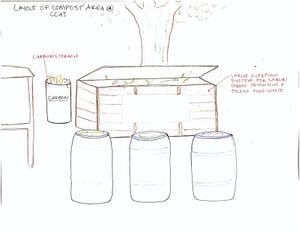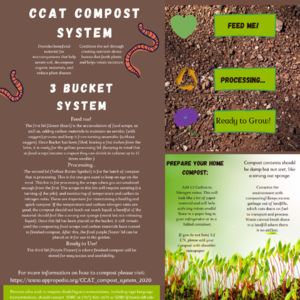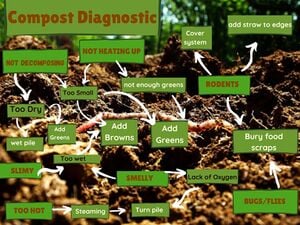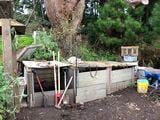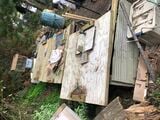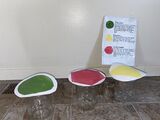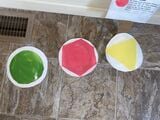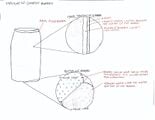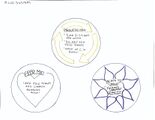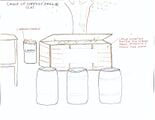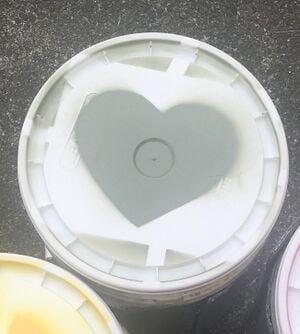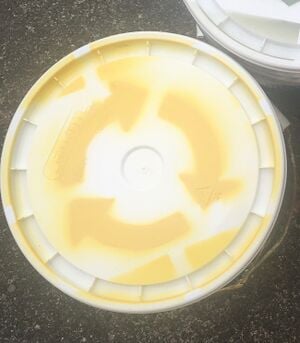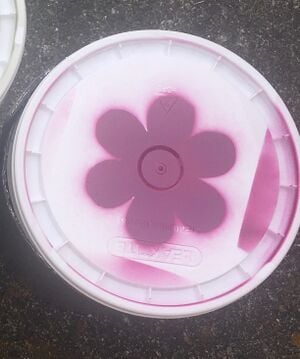|
|
| (89 intermediate revisions by 12 users not shown) |
| Line 1: |
Line 1: |
| {{305inprogress|May 23, 2020}}
| | [[File:Compost area layout ccat compost 2020.jpg|thumb|CCAT composting system design]] |
| ==Background==
| |
| The Campus Center for Appropriate Technology (CCAT) was established at Humboldt State University (HSU) in Arcata, California, USA in 1978. Since then CCAT has evolved into a living laboratory of sustainability that incorporates appropriate technology as a core operating philosophy. CCAT recently added a composting system into their facility where students, campus dining facilities, and community members can bring their compostable food waste. CCAT currently takes in over 50 lbs of community food waste a week to be composted. However, the current composting system has some specific issues such as: 1) lack of clarity/instructions for users 2) inefficient three-phase system and 3) rodent intrusion. These three aspects will be the primary focuses for our upgrade. It is our team goal to create a well-signed point-positive and user-friendly composting system that can be effectively utilized by anyone with or without a CCAT employee’s assistance. This project is set to be completed by the end of spring semester 2020.
| |
|
| |
|
| <gallery caption="Before Photos of Composting System"> | | {{Project data |
| Image:front_CCAT_compost.JPG|This is the front of the current compost system at [[CCAT]].
| | | authors = User:Lorelei, User:Shiloki587, User:Sarajune, User:Hcantrell |
| Image:Top_ccatcompost.JPG|Here is the top view of the current composting system at [[CCAT]].
| | | status = Designed |
| Image:Newsign_ccatcompost.JPG| This is the newly built compost signage holder made by [[CCAT]].
| | | instance-of = Compost bin |
| | | location = Arcata, California |
| | }} |
| | |
| | A community-sized composting system designed for The Community Center of Appropriate Technology (CCAT) at Cal Poly Humboldt in Arcata, CA. CCAT had a system in place that was not working for their desires and wanted to upgrade to a system that was more efficient and user-friendly. The design was developed to be self-serving and easy to use, with minimal labor. We developed different ideas, while prototyping to see what CCAT preferred and disliked. We settled on a 3 barrel system with rotating lids to have multiple batches of compost at one time, to keep a continuous rotation. As well as, a separate system in place for green waste made from the infrastructure of the previous composting system already in place. This system is 2 piles with slower output, to require less labor and attention. We designed informative signs and pamphlets to pair with our system, for optimal understanding and education. |
| | |
| | == Background == |
| | |
| | The Campus Center for Appropriate Technology (CCAT) was established at Cal Poly Humboldt (HSU) in Arcata, California, the USA in 1978. Since then CCAT has evolved into a living laboratory of sustainability that incorporates appropriate technology as a core operating philosophy. CCAT recently added a composting system into their facility where students, campus dining facilities, and community members can bring their compostable food waste. CCAT currently takes in over 50 lbs of community food waste a week to be composted. However, the current composting system has some specific issues such as 1) lack of clarity/instructions for users 2) inefficient three-phase system, and 3) rodent intrusion. These three aspects will be the primary focuses for our upgrade. It is our team goal to create a well-signed point-positive and user-friendly composting system that can be effectively utilized by anyone with or without a CCAT employee's assistance. This project is set to be completed by the end of the spring semester of 2020. |
| | |
| | <center> |
| | <gallery mode="traditional" widths="275" perrow="3"caption="Before Photos of Composting System"> |
| | File:front_CCAT_compost.JPG|This is the front of the current compost system at [[CCAT]]. |
| | File:Top_ccatcompost.JPG|Here is the top view of the current composting system at [[CCAT]]. |
| | File:Newsign_ccatcompost.JPG| This is the newly built compost signage holder made by [[CCAT]]. |
| </gallery> | | </gallery> |
| | </center> |
|
| |
|
| ==Problem statement== | | == Problem Statement == |
| The objective of this project is to update the current CCAT composting system. The current CCAT composting system is not user-friendly, rodent-resistant, or well-signed to guide composters through proper utilization. We plan to renovate the system so the community can add to and use the CCAT’s composting system with ease. Our hope is that after the renovations, using the system will be clearer and protected from rodents, leading to a more efficient and beneficial compost.
| |
|
| |
|
| ==Additional Information==
| | The objective of this project is to update the current CCAT composting system. The current CCAT composting system is not user-friendly, rodent-resistant, or well-signed to guide composters through proper utilization. We plan to renovate the system so the community can add to and use the CCAT's composting system with ease. Our hope is that after the renovations, using the system will be clearer and protected from rodents, leading to a more efficient and beneficial compost. |
| For more information or to learn more about Humboldt State University's CCAT, click the following link:
| |
| *https://ccat.humboldt.edu/
| |
|
| |
|
| For basic information on composting, click the following link:
| | === Client Criteria === |
| *http://www.thegardenofoz.org/composting101.asp==Literature Review==
| |
| This is a review of the available literature pertinent to the a specific project.
| |
|
| |
|
| ==Literature Review==
| | Working on an existing compost project that needs to be upgraded it has naturally had many hands-on it over time and will be utilized by many different people at CCAT, therefore we recognized the importance of listening to the desires of our client. In this case, CCAT has an extensive history with composting systems on their property and know in detail what has and hasn't worked for their community. The history and evolution of the compost system are complex, and CCAT employees were helpful in the process of defining criteria. CCAT gave us recommendations as well as explained their reasoning for why each criterion matter and the weight they place on it. This final list is a blend of what CCAT had prepared and our criteria. Most of our criteria fit nicely with theirs. |
| This is a review of the available literature pertinent to the a specific project. | |
|
| |
|
| ===Composting Basics=== | | {| class="wikitable" |
| Composting is a naturally occurring process, and is conducted by soil microorganisms and larger soil fauna that attack dead plant material and organic wastes to process it into an earth-like substance called humus. Plants feast on certain chemicals in the humus and this helps them grow. Although composting existed before human participation, the process is more commonly thought of as something that requires a human’s interference; utilizing the humus as a soil-building substance that nourishes plants and gardens. The benefits of compost were discovered when the human race was still in the early stages of hunting and gathering, most likely in the form of animal manure. When it was realized that plants would grow more vigorously in the patches where there was manure deposited, the process was applied more and more. This soon turned into a more selective application that the Native American’s and colonial Europeans used. In place of large amounts of manure, they would use two parts “muck” one part manure and this would give them three times the amount of fertilizing power than just manure by itself. This process was soon developed into the organic method of composting by Sir Albert Howard who experimented and slowly found the best compost consisted of three times as much plant matter as manure. These findings were then fine tuned into the methods we use today by J. I. Rodale who pioneered many of the composting methods we use today. <ref>The Rodale Guide to Composting - Jerry Minnich, Marjorie Hunt, and the editors of Organic Gardening magazine.</ref>
| | ! Criteria |
| | ! Constraints |
| | ! Weight<br>(1-10) |
| | |- |
| | ! Safety |
| | | All those working on the project and those who will engage with it will be safe |
| | | 10 |
| | |- |
| | ! Functionality |
| | | Minimizes the labor intensity of turning compost. The new system should simplify the composting process for both CCAT staff and HSU student body, be rat/rodent-proof, and utilize space appropriately. CCAT would like a designated sorting area to streamline compost output and manage clutter. |
| | | 10 |
| | |- |
| | ! Cost |
| | | Staying under budget. |
| | | 10 |
| | |- |
| | ! Aesthetics |
| | | New compost system should blend well with the existing CCAT atmosphere, utilize the space designated appropriately, and have clear signage. |
| | | 9 |
| | |- |
| | ! Longevity |
| | | New compost system will be the final, long-term solution for composting at CCAT. Materials and design will not require excessive maintenance |
| | | 8 |
| | |} |
|
| |
|
| ===Broad Science=== | | == Background Information and Research == |
| '''Aerobic Composting'''
| |
| There are two broad categories for composting that include many different methods. These categories are defined as aerobic and anaerobic compost. These two categories differ by the nature of their decomposition process. J. I. Rodale created the first advancements in the field of composting that was then fine tuned by Sir Albert Howard at the the Indian Council of Agricultural Research, creating the process of the Indore method of compost making, in which materials are layered sandwich fashion, then are turned (or mixed by earthworms) during decomposition. Also known as aerobic, or the hot compost method is a composting process that utilizes Oxygen. In this process, aerobic microorganisms are able to break down organic wastes and create carbon dioxide, ammonia, water, heat and humus in as little as 6 weeks; much quicker than its anaerobic counterparts. This method of composting is more efficient, not only is it quicker and can be used for larger operations, but it is less likely to emit odor, and to spread weeds and pathogens. <ref>The Rodale Guide to Composting - Jerry Minnich, Marjorie Hunt, and the editors of Organic Gardening magazine</ref>
| |
|
| |
|
| '''Anaerobic Composting'''
| | See the review of the available literature pertinent to the specific project at [[CCAT compost system 2020/Literature review]]. |
| Anaerobic composting also referred to as cold composting is defined by the decomposition that happens when oxygen is absent or in limited supply and is much slower than aerobic compost. With this method, microorganisms that thrive environments with little to no oxygen disintegrate and develop compounds including methane, organic acids, hydrogen sulphide and other substances. Cold composting is not a process that needs to be turned, and is smaller scale (typically less than 1 cubic meter), and takes about 6 months to make good effective compost. For those reasons, cold composting is not as widely used and will not be the focus of the CCAT composting project. <ref>https://www.researchgate.net/publication/265804376_Comparative_study_of_aerobic_and_anaerobic_composts_prepared_from_autumn_leaves_on_Zea_mays_L</ref>,<ref>https://earthmatter.org/wp-content/uploads/2014/04/History-of-Compost.pdf</ref>
| |
|
| |
|
| ===Composting Concerns=== | | == Prototyping == |
| '''Air'''
| |
|
| |
| Air is essential for the aerobic bacteria to proliferate, heat and digest the compost pile. The amount of air is important; if there is too much air flow, the microorganisms can heat the pile too much and destroy pathogens and weed seeds (EPA). To be sure a pile has enough air it must be turned every week or so, or placing poles in the pile and removing a few a day during the heat buildup process, or even pokig the pile with a pitchfork. The commercial way to achieve this aeration is using a compost tumbler with screened vents. This process, if turned four to five times a day and watered once daily can get you a finished product in as little as 14 days. Air can also be allowed to flow through the pile depending on the size of the particles in the compost, smaller is better because it is easier to break down, but too small of particles can prevent air flow. You can also place chicken wire at the bottom of the compost heap to aerate from the bottom of the pile.
| |
| <ref>The Rodale Guide to Composting - Jerry Minnich, Marjorie Hunt, and the editors of Organic Gardening magazine</ref>
| |
|
| |
|
| '''Moisture'''
| | Most people liked the system and felt it was straightforward. Most of the proposed changes were in the look of the design, such as, the colors and shapes. We learned that people did not care for using red on the lids, recommended we change the colors to purple or brown. One person recommended we change the symbol use for the finished compost to a flower. We took this advice and changed the other symbols to go better with the flower as well. Some also thought adding about 8-10 words onto the lids would be beneficial as well. CCAT thought that not having words on the lids, would encourage people to look at the sign. There was also a recommendation of adding instructional pictures on the sign. We have since revised our design after receiving feedback from the prototype. |
|
| |
| Good compost requires the correct amount of moisture. It should feel like the forest floor, a damp sponge if you will. At the University of Wisconsin in Madison, soil scientist James R. Love says that if you squeeze a handful of compost and water droplets leak out, the compost is too moist. It is a delicate balance between too much and too little moisture, and is best to check the moisture content of the compost when turning the pile. Too little moisture slows down the decomposition and prevents the pie from heating up; since the microorganisms need a steamy environment to do their job it is harder for them to work in this environment. Too much moisture drives out air and can wash away nutrients.<ref>https://www.epa.gov/sustainable-management-food/types-composting-and-understanding-process</ref> <ref>The Rodale Guide to Composting - Jerry Minnich, Marjorie Hunt, and the editors of Organic Gardening magazine</ref>
| |
|
| |
|
| '''Nitrogen'''
| | <center> |
| | <gallery mode="traditional" widths="275" perrow="3" caption="Lid Design Prototypes"> |
| | File:305 composting prototype1.jpg|Prototype of Rotating 3-lid Compost Design |
| | File:305 composting prototype2.jpg|Prototype Sign |
| | File:305 composting prototype3.jpg|Lid Design Prototype |
| | </gallery></center> |
|
| |
|
| Lack of nitrogen is one of the main reasons compost piles fail to heat up. There is scientific data on carbon to nitrogen ratios, but it is really just important to know that manure should comprise about a quarter to a fifth of the pile, with the rest being plant wastes. Chicken droppings are high in nitrogen content, along with horse manure, food scraps, blood meal, guano, and cottonseed meal. These materials will just about guarantee that your pille will get hot. <ref>https://www.epa.gov/sustainable-management-food/types-composting-and-understanding-process
| | == Construction == |
| </ref>,<ref>The Rodale Guide to Composting - Jerry Minnich, Marjorie Hunt, and the editors of Organic Gardening magazine</ref>
| |
|
| |
|
| '''Bacteria'''
| | Unfortunately, the COVID-19 global pandemic kept us from constructing a functioning system for CCAT. We did, however, design what the system would look like if we were able to follow through with the project. These designs were made in the hopes of CCAT being able to replicate them. |
|
| |
|
| Bacteria exist in the raw materials of compost. Since bacteria is responsible for most of the heat generation and decomposition of the compost it is a very important component. Many composters use garden soil in order to achieve the correct amount of bacteria, fungi, and actinomycetes. The soil also improves the texture of the pile.
| | <center> |
| <ref>http://compost.css.cornell.edu/microorg.html</ref>,<ref>The Rodale Guide to Composting - Jerry Minnich, Marjorie Hunt, and the editors of Organic Gardening magazine</ref>
| | <gallery mode="traditional" widths="275" perrow="3" caption="CCAT Final Design Templates> |
| | File: barrel_design_ccat_compost_2020.jpg|Design for the barrels for the CCAT composting system |
| | File: lid_design_ccat_compost_2020.jpg|3-lid design for CCAT composting system |
| | File: compost_area_layout_ccat_compost_2020.jpg|Layout for the CCAT composting system |
| | </gallery></center> |
|
| |
|
| '''Heat'''
| | === Proposed Timeline === |
|
| |
|
| It is very difficult to get a pile working in the cold months, which is just about all of the time here in Humboldt county. This is why heat and insulation of the pile is very important. Covering the pile when it rains is key to keeping the heat in your compost. To do this, you can harvest the compost in the fall in order to make room for the new additions that will be needed to keep the microbes warm. Be sure to put the compost in a sunny part of the land. You can rebuild compost with a layer of leaves, or with straw, cardboard or sawdust. Put the active part in the middle, and then cover it with more leaves and straw. This insulates the active compost.
| | <center> |
| <ref>https://learn.eartheasy.com/articles/tips-for-winter-composting/</ref>,<ref>https://www.epa.gov/sustainable-management-food/types-composting-and-understanding-process</ref>,<ref>The Rodale Guide to Composting - Jerry Minnich, Marjorie Hunt, and the editors of Organic Gardening magazine</ref> | |
|
| |
|
| '''Sufficient size'''
| | {| class="wikitable" |
|
| | ! Dates |
| When a pile is heating, the optimum temperature is 140℉. Due to insulation purposes, the larger the pile the better. If the pile is below 3 cubic feet it will be difficult to get it to 140℉. The best minimum size is 3 square feet and 3 feet high. The middle portion of the pile is the part that is heated the most, so when turning a pile make sure that the more raw, undigested materials are moved towards the canter, which can cause a second heating to decompose said materials.<ref>The Rodale Guide to Composting - Jerry Minnich, Marjorie Hunt, and the editors of Organic Gardening magazine</ref>
| | ! Objective |
| | |- |
| | | 3/2/2020 |
| | | Tentative budget. Present alternative solutions to CCAT |
| | |- |
| | | 3/9/2020 |
| | | First project photos. Construct a prototype. Make materials list and begin formulating building plans. |
| | |- |
| | | 3/23/2020 |
| | | Begin construction process. Draft Appropedia page. |
| | |- |
| | | 4/13/2020 |
| | | Continue construction, keeping criteria in mind. Check-in with CCAT. Touch up anything needed. |
| | |- |
| | | 4/27/2020 |
| | | Final Appropedia Page and project write-up. Construction completed |
| | |- |
| | | 5/4/2020 |
| | | Reflection and Final Presentation. |
| | |} |
|
| |
|
| '''Organic Matter'''
| | </center> |
|
| |
|
| Any organic matter or plant material can compost, but one must think of the drawbacks of certain types of materials. Leaves are a good material to use, but unless they are finely shredded can turn into tough layers that can circumvent heating. Plant matter must be broken down into fine pieces so that the stalky matter high in lignin resists less to the breakdown process.
| | === Costs === |
| <ref>https://www.epa.gov/sustainable-management-food/types-composting-and-understanding-process</ref>, <ref>The Rodale Guide to Composting - Jerry Minnich, Marjorie Hunt, and the editors of Organic Gardening magazine</ref>
| |
|
| |
|
| ===Types of composting===
| | For CCAT's compost system upgrade, we have a total budget allocation from CCAT of $350. We are hoping to keep total expenses within that overall budget and reuse any appropriate items from the current CCAT compost system to reduce costs and the carbon footprint of the new system. |
| Nearly all methods stem from the famous Indore method developed by Sir Albert Howard. Basic needs are air, moisture, energy food (carbon) and protein food (nitrogen) in the right proportion, and warmth. As long as all of these basic requirements are taken care of, other improvising can be done.
| |
|
| |
|
| Most composting systems are aerobic, so they require adequate air to be available throughout the pile. Most common is to turn the pile at regular intervals. More frequent the turning, the faster the decomposition. There are creative ways to introduce air into static piles and avoid having to turn so frequently. For example, burying perforated drainpipe at intervals within the pile. Natural convection is sufficient to circulate air throughout a pile.
| | <center> |
|
| |
|
| You want your compost to be about as damp as a moist sponge. No moisture should come out when squeezing a handful. But if not moist enough, it will slow down the decomposition and prevents the pile from heating up. Steamy environment for microorganisms. Select a site that drains easily for humid climates so the compost never sits in a pool of water. The turning process releases moisture. If the pile is soggy, more absorbent materials should be added (e.g. leaves or dried grass clippings).
| | {| class="wikitable" |
| | ! Quantity |
| | ! Material |
| | ! Source |
| | ! Cost ($) |
| | ! Total ($) |
| | |- |
| | | 3 |
| | | Plastic Barrels |
| | | Donations |
| | | align="right"| $0 |
| | | align="right"| $0 |
| | |- |
| | | 10 |
| | | Wood Pallets |
| | | Donations |
| | | align="right"| $0 |
| | | align="right"| $0 |
| | |- |
| | | 3 |
| | | Vermin Mesh 24 in. W x 5 ft. |
| | | Ace Hardware |
| | | align="right"| $10.00 |
| | | align="right"| $30 |
| | |- |
| | | 1 |
| | | Compost Crank |
| | | Sun Frost |
| | | align="right"| $55 |
| | | align="right"| $55 |
| | |- |
| | | 75 ft^2 |
| | | Insulation |
| | | Ace Hardware |
| | | align="right"| $0.60/ ft^2 |
| | | align="right"| $45 |
| | |- class="sortbottom" |
| | | colspan="4" align="right" | '''Total Cost''' |
| | | align="right"| '''$130''' |
| | |} |
|
| |
|
| Carbon is for energy and nitrogen for growth. Ideal C/N ratio is between 25:1 and 30:1, carbon being the higher number. If there is too much nitrogen to carbon, it will be lost as ammonia, detected by the smell. Generally only lasts for a day or two.
| | </center> |
|
| |
|
| When the temperature drops below 55 degF, bacteria become dormant. Insulation is great way to keep temperatures up. Optimum temperatures are 140 degF or 60 degC. Pile must be at least 3 feet in each dimension to provide for necessary critical mass. For best heating, a heap 4 or 5 feet square rising up 4 feet is good. Temperature decreases toward the outside of the pile. When turning, it is a good idea to shovel undigested materials from the outside into the middle of the pile.
| | == Operation == |
| The more diverse the compost materials, the more likely there is a good balance of bacteria. Sprinkling a thin coating of good topsoil or finished compost from a previous batch over each layer of new materials is the best way to inoculate your pile with the right cultures.
| |
|
| |
|
| When choosing a method, factors that need to be taken into account are space and construction available, total need for compost in terms of the area under cultivation and the rate of use, time to be given to the project, the human and mechanical energy available, the equipment owned or obtainable, the materials at hand or easily procurable, and special crop needs. Methods vary from quick, hot composting that requires effort and attention, to slow, cool techniques that are less trouble. Time needed for a quick compost is generally less than 8 weeks and as little as 2. Speed is achieved by keeping aeration levels high. Monitoring temperature is helpful, turning it as soon as temperature drops. A drawback is that the whole pile must be built at once. Scraps must be stored up until you’re ready to start a new pile. <ref>Gershuny, Grace, and Deborah L. Martin. The Rodale Book of Composting: Simple Methods to Improve Your Soil, Recycle Waste, Grow Healthier Plants, and Create an Earth-Friendly Garden. New York: Rodale Books, 2018.</ref>
| | === Maintenance === |
|
| |
|
| Appropriate materials for composting are garden debris, manures, vegetable trimmings, unprinted paper and cardboard, and various absorbent materials. Useful way to assure adequate ratio of carbon to nitrogen is doing alternating layers of “browns” and “greens”. Phosphorus is also required, and is found in plant debris and manures. Ideal pH level for most microorganisms is 7.0 or neutral. Adding lime to the compost can keep the pile from becoming too acidic, but it can promote the loss of nitrogen. Minimum dimensions for bin should be 3x3 ft and height at 4-6 ft. One side should be removable, so that compost can be reached. Height of pile should not exceed 6 ft. Compost should be fluffed.
| | We have developed instructions and a brief schedule one should follow if implementing the system. |
| <ref>Golueke, Clarence G. Composting: a Study of the Process and Its Principles. Emmaus: Rodale Press Book Division, 1976.</ref>
| |
|
| |
|
| ====Aerated (turned) Windrow Composting==== | | === Schedule === |
| Suited for large volumes, such as those generated by entire communities. Involves forming organic waste into rows of long piles called “windrows” and periodically aerating them by turning the piles. Ideal pile height is 4-8 ft tall and 14-16 ft wide. This size is large enough to generate enough heat and maintain temperatures, but small enough to allow oxygen flow to the core. Suitable for diverse waste such as yard trimmings, grease, liquids, and animal byproducts (such as fish and poultry wastes). Often requires large tracts of land, sturdy equipment, a continual supply of labor to maintain and operate the facility, and patience to experiment with various materials mixtures and turning frequencies. In rainy seasons, shapes of the piles can be adjusted so that water runs off the top of the piles rather than absorbed. Leachate is a liquid released during the process, it can contaminate local ground and surface water. It should be collected and treated. <ref>“Types of Composting and Understanding the Process.” EPA. Environmental Protection Agency, August 29, 2016. https://www.epa.gov/sustainable-management-food/types-composting-and-understanding-process.</ref>
| |
|
| |
|
| ====Aerated Static Pile Composting====
| | ;Daily |
| Produces compost relatively quickly (3-6 months). Suitable for a relatively homogenous mix of organic waste and works well for larger quantities. Does not work well for animal byproducts or grease. Organic waste is mixed in a large pile, and layers of loosely piled bulking agents (e.g., wood chips, shredded newspaper) are added so that air can pass from the bottom to the top of the pile. Requires careful monitoring to ensure that the outside of the pile heats up as much as the core. May require significant cost and technical assistance.
| |
| <ref>“Types of Composting and Understanding the Process.” EPA. Environmental Protection Agency, August 29, 2016. https://www.epa.gov/sustainable-management-food/types-composting-and-understanding-process.</ref>
| |
|
| |
|
| ====Vermicomposting====
| | * Adding proper N:C ratios of waste to the system. |
| Redworms in bins that feed on food scraps, yard trimmings, and other organic matter. The materials broken down by the worms is produced into high quality compost called castings. A pound of mature worms, which is approximately 800-1,000 worms, can eat up to a half a pound of organic material per day. Usually takes about three to fourth months for usable castings. The worms can also produce what is called “worm tea” which is a high-quality liquid fertilizer. The best temperatures for vermicomposting range from 55-77 degree F, and avoidance of direct sunlight. Most common and preferred choice for composting. Worms produce castings that have lower nitrogen compared to other composting methods. Do not house in metal containers, copper can leech out and become toxic. Need to be connected to the ground so nutrients can go right into soil. Need to be kept out of sun, frost, and rain. Also not too cold. Worms are temperamental and will leave if not happy. <ref>“Types of Composting and Understanding the Process.” EPA. Environmental Protection Agency, August 29, 2016. https://www.epa.gov/sustainable-management-food/types-composting-and-understanding-process.</ref>, <ref>“8 Methods of Composting.” Direct Compost Solutions, November 11, 2019. https://www.directcompostsolutions.com/8-methods-composting/.</ref>
| |
|
| |
|
| ====The University of California Method====
| | ;Weekly |
| Aims for more heat and faster decomposition. A minimum volume of 1 cubic yard, but a greater volume may be required in cold weather. Bin constructed from wood and hardware cloth, wood alone, or concrete. Materials should be reduced to pieces of 6-8 inches. Turning is essential. Recommended turning schedule every 3 days.
| |
| <ref>Gershuny, Grace, and Deborah L. Martin. The Rodale Book of Composting: Simple Methods to Improve Your Soil, Recycle Waste, Grow Healthier Plants, and Create an Earth-Friendly Garden. New York: Rodale Books, 2018.</ref>
| |
|
| |
|
| ====Raised-Bin Method====
| | * Turn compost briefly using compost crank or shovel. |
| Open-hearth-bottom bin sitting on cement slab. A grill made from pipe sits above the slab. Allowing air into the center of the heap. As the pile heats up, it pulls the cooler air from the ground, aerating throughout the pile.
| | * Check on food donations and proper ratios. Add based on the flowchart diagnostic. |
| <ref>Gershuny, Grace, and Deborah L. Martin. The Rodale Book of Composting: Simple Methods to Improve Your Soil, Recycle Waste, Grow Healthier Plants, and Create an Earth-Friendly Garden. New York: Rodale Books, 2018.</ref>
| | * Switch over lids as needed. |
|
| |
|
| ====Open Air Composting (Bay Composting)====
| | ;Monthly |
| Usually a pile of green and brown matter. Generally considered a hot composting method. A bay is constructed using anything handy, such as wire cages or bins. Requires monitoring, watering, turning, and spreading. Attracts worms, but will not stay if conditions are not perfect. Temperature and pH are very important. Nitrogen and carbon ratio are very important. 2-3 bays are optimal for the process time. Worm friendly food only. If not the right mix, it can smell. Takes a long time and turning to aerate is essential. Ideal for a farmer with lots of green waste.
| |
| <ref>“8 Methods of Composting.” Direct Compost Solutions, November 11, 2019. https://www.directcompostsolutions.com/8-methods-composting/.</ref>
| |
|
| |
|
| ===What Can be Composted===
| | * Prepare to harvest compost after decomposed. It will be much lighter in weight and airy and you should see little food scraps remaining. |
| Compost is the process of food waste being processed into humus with the help of microorganisms. This process does not include all food waste though. There are specific food items that are best not to place in your compost pile. These items include Meat, Bones, Fish, Fats, Dairy. These products can overheat your compost and make it odorous, and will also attract animals. One would want to avoid having any type of synthetic materials in the compost pile as well (i.e. herbicides and pesticides). These items can withstand the composting process and remain in the final product.
| | * Empty out and clean holes using water. |
| <ref>https://www.planetnatural.com/composting-101/making/what-to-use/</ref>
| |
|
| |
|
| ===How to make your compost smell less===
| | ;Yearly |
| Odor in compost is caused by multiple factors. It is possible to have odorless compost, but only if you keep these components in mind. The ratios of your compost must be correct. As stated before, it is important to know that manure should comprise about a quarter to a fifth of the pile, with the rest being plant wastes. Odor in compost is caused by anaerobic spots in the compost, or the compost not receiving enough oxygen. The process of composting is a process that creates many odorous compounds, and if these compounds are not ventilated, it can disrupt your composting process and singe your nasal passages.
| |
| <ref>Composting of Agricultural and Other Wastes - J.K.R Gasser</ref>,<ref>https://www.questia.com/library/journal/1G1-268789681/trash-talk-how-to-compost-safely</ref>
| |
|
| |
|
| ===Composting and Pests===
| | * Check on the status of buckets. Replace any decomposing wood on the overflow system. Patch any holes. |
| Composting can be a fairly straightforward concept because the decomposition process continues whether one fusses over their organic matter, or not. As such, a properly constructed and managed compost system has no odor <ref>Cromell, C. (2010). Composting for dummies. Hoboken, NJ: Wiley Publishing, Inc.</ref>.This is often easier said than done. If decomposition within a system is not occuring at optimal rates the most common side effect it can lead to is unsatisfactory odors <ref>Haug, R. T. (1993). The practical handbook of compost engineering. Boca Raton, FL: Lewis Publishers.</ref>. Controlling odors is generally regarded as the most difficult and persistent problem within composting practices. Significant advances were made from the 1980s - 1990s to dial in the science of odor management in composting systems <ref>Haug, R. T. (1993). The practical handbook of compost engineering. Boca Raton, FL: Lewis Publishers.</ref>. Different composting odors are indicative of different problems. For example, if there is a strong ammonia odor it is usually caused by an overabundance of nitrogen/greens <ref>Cromell, C. (2010). Composting for dummies. Hoboken, NJ: Wiley Publishing, Inc.</ref>. If a rotten egg smell is present the compost has become compressed and/or too wet meaning air cannot properly permeate and anaerobic bacteria is flourishing -- this can be fixed by oxygenating the compost via turning more often and incorporating more leaves/straw/shredded paper to soak up excess moisture <ref>Cromell, C. (2010). Composting for dummies. Hoboken, NJ: Wiley Publishing, Inc.</ref>.
| |
|
| |
|
| ====Insects==== | | === Instructions === |
| Nuisance odors are doubly troublesome as they also attract insects and rodents. Insects such as fruit flies, beetle larvae, worms, and other bugs can be found in and around a compost pile. Fruit flies will be present on compost piles when fruit or vegetable skins are exposed. To avoid this, bury fresh food scraps deep within the compost pile <ref>Cromell, C. (2010). Composting for dummies. Hoboken, NJ: Wiley Publishing, Inc.</ref>. Beetle larvae, while visually unappealing, do not actually pose a threat to your compost system. However, if their population has become so large that they are negatively affecting surrounding plants and root systems you should contact a local nursery to identify which species live in your area and how to effectively control them <ref>Cromell, C. (2010). Composting for dummies. Hoboken, NJ: Wiley Publishing, Inc.</ref>. Worms are beneficial and integral to composting efforts, so they are not to be discouraged. Lots of other bugs in, around, and throughout your compost pile are nature’s decomposers and are a positive sign that your compost is thriving.
| |
|
| |
|
| ====Rodents====
| | This is a step-by-step guide on how to maintain and operate. |
| Rodents such as mice and rats can be attracted to compost. Mice often seek warm, dry, organic materials to build a nest. If a compost system that isn’t turned regularly has layers of straw and leaves, mice will start to inhabit it. This can be avoided by frequently turning your compost. Rats can be more problematic. To avoid rats: meat, bones, greases, fats, oils, and dairy products should not be included in composting <ref>Composting At Home. (2019, November 13). Retrieved from https://www.epa.gov/recycle/composting-home</ref> and blood meal should be avoided as a nitrogen source <ref>Olney, K. (2015, June 8). How to Compost Without Attracting Pests. Retrieved from http://www.safebee.com/home/how-compost-without-attracting-pests</ref>. If vermin persist, one may need to further pest-proof their composting system with better more tight-fitting lids and wire mesh covering any aeration holes <ref>Cromell, C. (2010). Composting for dummies. Hoboken, NJ: Wiley Publishing, Inc.</ref>.
| |
|
| |
|
| | '''How to Use Rotating 3-lid Design |
| | ''' |
|
| |
|
| '''Terminology'''
| | {{Step |
| | | number = 1 |
| | | text = The first lid (Green Heart) is the accumulation of food scraps, as well as, adding carbon materials to maintain an aerobic (with oxygen) process and keep it from turning anaerobic (without oxygen). Once Bucket has been filled, leaving a few inches from the brim, it is ready for the yellow processing lid. (keeping in mind that as food scraps become compost they can shrink in volume up to 15 times smaller.) |
| | | image = Compost lid1.jpg |
| | | caption = First Lid |
| | }} |
|
| |
|
| ''Organic wastes:''
| | {{Step |
| Organic waste also known as green waste is typically defined as organic material like food scraps, garden and lawn clippings. Organic waste can also include plant and animal based material that is biodegradable and other carbon based materials such as paper cardboard and timber.
| | | number = 2 |
| <ref>https://environmentvictoria.org.au/resource/organic-waste/</ref>
| | | text = The second lid (Yellow Rotate Symbol) is for the batch of compost that is processing. This is the one you want to keep an eye on the most. This bin is for processing the scraps when you accumulated enough from the first. The scraps in this bin will require aerating (i.e. turning off the pile), and monitoring of temperature and carbon to nitrogen ratio. These are important for maintaining a healthy and quick compost. If the temperature and carbon-nitrogen ratio are good, the compost should not leech out much liquid, a handful of the material should feel like a wrung-out sponge (moist but not releasing liquid). Once this lid has been placed on the bucket, it will remain until the composting food scraps and carbon materials have turned to finished compost. After this, the final purple flower lid can be placed on it for use in the garden. |
| | | image = Compost lid2.jpg |
| | | caption = Second Lid |
| | }} |
|
| |
|
| ''Humus:''
| | {{Step |
| Humus is the fertile organic component of soil that is formed by the decomposition of leaves and other plant material by soil microorganisms.
| | | number = 3 |
| <ref>https://www.dictionary.com/browse/humus</ref>
| | | text = The third lid (Purple Flower) is where finished compost will be stored for easy access and availability. |
| | | image = Compost lid3.jpg |
| | | caption = Third Lid |
| | }} |
|
| |
|
| ''Soil microorganisms:''
| | === Educational Materials === |
| Soil microorganisms isa broad term used to describe small organisms that live in soil and assist the decomposition process. Bacteria, actinomycetes, fungi, algae and protozoa are the 5 different microorganisms that exist in soil, and each serve a different function in the decomposition process.
| |
| <ref>https://en.wikipedia.org/wiki/Soil_microbiology</ref>
| |
|
| |
|
| ''Soil flora:''
| | Here is the sign that will fill in the box at CCAT. It is located upon entering the compost area and is 35" by 35". |
| Soil flora refers to the microorganisms in the soil that are more static. These include bacteria, fungi and algae.
| |
| <ref>https://scialert.net/fulltext/?doi=ppj.2006.125.142</ref>
| |
|
| |
|
| ''Soil fauna:''
| | [[File:CCAT compost signage 2020 covid19.png|thumb|center|CCAT compost signage]] |
| Soil fauna is defined as the microorganisms in the soil that become more active once the food source is depreciated.
| |
| <ref>https://scialert.net/fulltext/?doi=ppj.2006.125.142</ref>
| |
|
| |
|
| ''Aerobic:'' | | '''Composting 101 Educational Pamphlet:''' |
| Aerobic means to involve oxygen.
| | https://www.appropedia.org/images/6/66/Composting_101_Education_Pamphlet_for_CCAT.pdf |
|
| |
|
| ''Anaerobic:''
| | == Conclusion == |
| Anaerobic can be defined as involving, or requiring the absence of free oxygen.
| |
|
| |
|
| ''Pathogens:''
| | === Lessons learned === |
| A Pathogen is a bacterium, virus or any other microorganism that can cause disease. In soil, pathogens include organisms such as fungi, bacteria and nematodes, and cause things such as root disease.
| |
| <ref>https://s3.wp.wsu.edu/uploads/sites/2073/2014/03/113007.pdf</ref>
| |
|
| |
|
| ''Turn:''
| | We learned that there are a lot of variables to consider for the CCAT composting system. There have multiple previous iterations of a composting system at CCAT that have all ultimately been unsuccessful and so we were very motivated to create a final, long-term, viable composting system for CCAT. There are a lot of people who have access to the composting system at CCAT including volunteers, community members, and people dropping off their food scraps to be composted. These are additional factors that complicate the final compost system we deliver. We realized that clear signage and educational materials are needed to guide the many people working with the CCAT composting system. |
| To turn a compost pile is to mix the materials in the compost pile in order to allow oxygen in.
| |
|
| |
|
| ''Bacteria:''
| | === Next steps === |
| Bacteria perform the decomposing functions in soil. By digesting organic residues from enzymes released into the soil bacteria recycles the soil’s nutrients and contributes to soil health.
| |
| <ref>http://www.soilquality.org.au/factsheets/soil-bacteria-and-fungi-nsw</ref>
| |
|
| |
|
| ''Fungi:''
| | As we go into the future, the next steps for our project are to construct and implement at The Community Center for Appropriate Technology (CCAT). We also will continue our satellite projects to supplement the CCAT system for people to reference for at-home composting options. |
| Similar to bacteria, fungi are also decomposers that convert hard to digest organic material into forms that other organisms can digest more easily.
| |
| <ref>https://www.nrcs.usda.gov/wps/portal/nrcs/detailfull/soils/health/biology/?cid=nrcs142p2_053864</ref>
| |
|
| |
| ''Actinomycetes:''
| |
| Actinomycetes is a term known for a group of common soil microorganisms, they are known for decomposing more resistant organic materials such as chitin which is a complex sugar found in the outer skeleton of insects and elsewhere.
| |
| <ref>https://www.asmscience.org/content/education/imagegallery/image.3180</ref>
| |
|
| |
|
| ===Local Environment and it's Constraints=== | | === Troubleshooting === |
| Humboldt County’s weather ranges from a summer high of 75 degrees Fahrenheit, to a winter low of 39 degrees F. The average rainfall is 55 inches per year. <ref>https://www.bestplaces.net/climate/county/california/humboldt</ref> Temperature is a physical property that affects the rate of decomposition, <ref>http://compost.css.cornell.edu/physics.html</ref> however is something that can be captured through the pile. Best practices look around 65 degrees Celsius (about 149 F), any hotter and the beneficial microbes can die. During the thermophilic stage of composting, most decomposing occurs and is responsible for destroying thermosensitive pathogens, fly larvae, and weed seeds. <ref>http://compost.css.cornell.edu/physics.html</ref> In colder climates, building a pile deeper than 5 feet into the ground will insulate better than a shallow hole. <ref>Barker, Allen V. 2010. Science and Technology of Organic Farming. Boca Raton, Florida ; London, [England] ; New York: CRC Press.</ref>
| |
|
| |
|
| ===Selecting a Suitable Composting Site===
| | If your compost system is having difficulties, check out this diagnostic to help get finished compost from your system: |
| Your site is important in allowing contaminated water losses to be controlled. Sitting compost has added risks of leeching chemicals onto land. One way to prevent problems of water pollution is to add concrete platform beneath with access to water recovery. Rotating the pile is also a consideration to avoid localized accumulation of NO− 3 underneath. <ref>, J., Girardin, P. Environmental Impacts of Farm-Scale Composting Practices. Water, Air, & Soil Pollution 153, 45–68 (2004).</ref> Selecting a site in partial shade, or adding windbreaks is helpful to prevent drying out. <ref>Barker, Allen V. 2010. Science and Technology of Organic Farming. Boca Raton, Florida ; London, [England] ; New York: CRC Press.</ref> With consideration for trees around, these can sometimes send roots near the system and uptake much of the nutrients. <ref>Fritsch, Al., and Paul. Gallimore. 2007. Healing Appalachia: Sustainable Living through Appropriate Technology. Lexington: The University Press of Kentucky.</ref>
| |
|
| |
|
| ===Materials to Consider===
| | [[File:Compost flow chart sjk.jpg|thumb|center|Compost flow chart to help solve composting issues]] |
| Leeching of nutrients can be a hazard in a closed system. Having a bottle liner can help mitigate this. <ref> Fritsch, Al., and Paul. Gallimore. 2007. Healing Appalachia: Sustainable Living through Appropriate Technology. Lexington: The University Press of Kentucky.</ref>
| |
| Using waste pallets or pine slates helps promote airflow. Pressure-treated lumber should be avoided. Although they will last longer, they can cause chemical runoff harming the compost and surrounding land. <ref> Fritsch, Al., and Paul. Gallimore. 2007. Healing Appalachia: Sustainable Living through Appropriate Technology. Lexington: The University Press of Kentucky.</ref>
| |
| Metal is not a helpful material due to its rusting properties over time. This is because composting is often a wet process and the system will most likely be exposed to the elements. <ref>https://www.epa.gov/recycle/how-create-and-maintain-indoor-worm-composting-bin</ref>
| |
| Ideas to help sustain aeration include drilling air holes, the addition of aeration pipes, forced airflow, and mechanical mixing or turning. <ref> http://compost.css.cornell.edu/physics.html</ref>
| |
|
| |
|
| ===Designing interpretive materials===
| | For basic information on composting, click the following link: |
| According to ______ interpretive materials for composting should include....
| |
|
| |
|
| ==Construction==
| | * http://www.thegardenofoz.org/composting101.asp |
|
| |
|
| ===Client Criteria=== | | == Satellite Projects == |
| Working on an existing compost project that needs to be upgraded it has naturally had many hands on it over time and will be utilized by many different people at CCAT, therefore we recognized the importance of listening to the desires of our client. In this case, CCAT has an extensive history with composting systems on their property and know in detail what has and hasn’t worked for their community. The history and evolution of the compost system is complex, and CCAT employees were helpful in the process of defining criteria. CCAT gave us recommendations as well as explained their reasoning for why each criterion matter and the weight they place on it. This final list is a blend of what CCAT had prepared and our criteria. Most of our criteria fit nicely with theirs.
| |
|
| |
|
| ===Criteria===
| | The team made the following satellite projects to bolster the educational value during a shelter in place orders of the way back in 2020, remember those days...: |
| {| class="wikitable sortable"
| |
| |-
| |
| ! Criteria
| |
| ! Constraints
| |
| ! Weight <br>(1-10)
| |
| |-
| |
| | '''Safety'''
| |
| | All those working on project and those who will engage with it will be safe
| |
|
| |
|
| | <center>10</center>
| | * [[Lorelei at home composting with kids]] |
| |-
| | * [[Kelsey 3-lid 5-gallon bucket design]] |
| | '''Functionality'''
| | * [[Sara June 2 bay pallet system]] |
| | Minimizes the labor intensity of turning compost. The new system should simplify the composting process for both CCAT staff and HSU student body, be rat/rodent proof, and utilize space appropriately. CCAT would like a designated sorting area to streamline compost output and manage clutter.
| | * [[Hannah Stacked bin system]] |
| |<center>10</center>
| |
| |-
| |
| | '''Cost'''
| |
| | Staying under budget.
| |
| |<center>10</center>
| |
| |-
| |
| | '''Aesthetics'''
| |
| | New compost system should blend well with the existing CCAT atmosphere, utilize the space designated appropriately, and have clear signage.
| |
| |<center>9</center>
| |
| |-
| |
| | '''Longevity'''
| |
| | New compost system will be the final, long term solution for composting at CCAT. Materials and design will not require excessive maintenance
| |
| | <center>8</center>
| |
| |-
| |
| |}
| |
|
| |
|
| ==Proposed timeline== | | == Team == |
| {| class="wikitable sortable"
| |
| |-
| |
| ! Dates
| |
| ! Objective
| |
| |-
| |
| | 3/2/2020
| |
| | Tentative budget. Present alternative solutions to CCAT
| |
| |-
| |
| | 3/9/2020
| |
| | First project photos. Construct a prototype. Make materials list and begin formulating building plans.
| |
| |-
| |
| | 3/23/2020
| |
| | Begin construction process. Draft Appropedia page.
| |
| |-
| |
| | 4/13/2020
| |
| | Continue construction, keeping criteria in mind. Check-in with CCAT. Touch up anything needed.
| |
| |-
| |
| | 4/27/2020
| |
| | Final Appropedia Page and project write up. Construction completed
| |
| |-
| |
| | 5/4/2020
| |
| | Reflection and final Presentation.
| |
| |-
| |
| |}
| |
|
| |
|
| ==Costs==
| | * [[User:Lorelei|Lorelei]] |
| For CCAT's compost system upgrade we have a total budget allocation from CCAT of $350. We are hoping to keep total expenses within that overall budget and reuse any appropriate items from the current CCAT compost system to reduce costs and the carbon footprint of the new system.
| | * [[User:Shiloki587|Kelsey]] |
| | * [[User:Sarajune|Sara June]] |
| | * [[User:Hcantrell|Hannah]] |
|
| |
|
| {| class="wikitable sortable"
| | == References == |
| ! Quantity !! Material !! Source !! Cost ($) !! Total ($)
| |
| |-
| |
| | 3 || Barrels || Renner Petroleum
| |
| |align="right"| $10.00
| |
| |align="right"| $30.00
| |
| |-
| |
| | 10 || Wood Pallets || Donations
| |
| |align="right"| $0
| |
| |align="right"| $0
| |
| |-
| |
| | 150 ft^2 || Chicken Wire || Ace
| |
| |align="right"| $10/10ft^2
| |
| |align="right"| $150
| |
| |-
| |
| | 1 || Compost Crank || Online
| |
| |align="right"| $55
| |
| |align="right"| $55
| |
| |-
| |
| | 75 ft^2 || Insulation || Sun Frost
| |
| |align="right"| $0.60/ ft^2
| |
| |align="right"| $45
| |
| |-class="sortbottom"
| |
| |colspan="4" align="right" | '''Total Cost'''
| |
| |align="right"| '''$280'''
| |
| |}
| |
| | |
| ==References== | |
| {{Reflist}}
| |
|
| |
|
| [[Category:Engr305 Appropriate Technology]]
| | <references /> |
|
| |
|
| [[Category:CCAT]]
| | {{Page data |
| | | part-of = Engr305 Appropriate Technology |
| | | keywords = CCAT, composting, education |
| | | sdg = SDG12 Responsible consumption and production |
| | | organizations = Cal Poly Humboldt, Campus Center for Appropriate Technology (CCAT) |
| | }} |
|
| |
|
| | [[Category:CCAT]] |
| [[Category:Composting]] | | [[Category:Composting]] |
|
| |
| [[Category:Education]] | | [[Category:Education]] |
